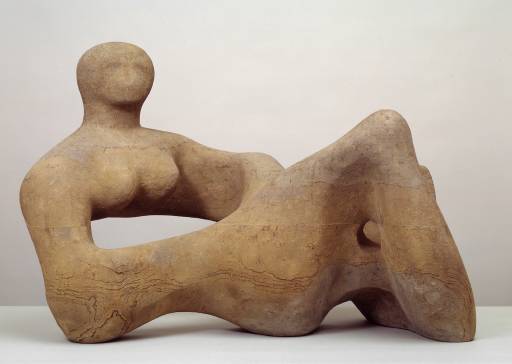Henry Moore; as edgy as a Yorkshire outcrop, as soft as rain.
For Henry Moore, art was the expression of the imagination rather than representation. He was not just a craftsman, he was an explorer. With typical Yorkshire bluntness, he declared, ‘I express myself in shapes; that’s my language.’ The same recurrent shapes featured prominently in Moore’s work, the reclining female figure, the holes, the mother and child.
Moore was the youngest of seven children from Castleford. His father was a miner. They were not well off. His early work was influenced by the primitive; Etruscan funerary monuments, pre Columbian Mexican figures, the statues on Easter Island, Sumerian art, African masks. These forms appealed directly to his emotions. His reclining figures bear a striking resemblance to the Chac Mool, the Gods in the Yucatan temples. Action during the First World War traumatised the young man and must have added its influence to his deformed bodily shapes with holes in them.
Most of Moore’s sculptures were direct carvings, like Jacob Epstein’s. He wanted to keep faith with the medium. He liked to use local stone; the veins and colour and blemishes in the stone became an integral part of his sculptures. Like Michelangelo, who quarried his own stone at Carrera, Moore had a feeling for the material, lived with it until something meaningful crystallised in it. Craft then shaped it to the final realisation. He placed his large reclining figures with the gaps and holes in the landscape, so they not only part of the landscape, but you could see the landscape through them.
Moore didn’t achieve public recognition until the Second World War when Kenneth Clark appointed him a wartime artist. His images of people asleep on the platforms of tube stations in London summed up the solid, indomitable spirit of Londoners during the blitz and expressed something of hilself. He would go down into the underground stations, incongruous in his suit and tie and just observe; he didn’t want to intrude. He made notes on the way out and then drew what he saw later.
Moore’s sculptures, outside the art gallery in Leeds or spaced out in Bretton Park, seem as familiar as Yorkshire pudding, but a new exhibition of his work shows him as edgy and awkward as a Pennine outcrop. He was influenced by the work of TS Eliot, DH Lawrence and Sigmund Freud. For Moore, the body as object was erotic, vulnerable, violated, visceral, deformed, open and fragmented. It allied sex and death; a literal, honest counterpoint to Stalinist ‘realism’; he showed it as it was, not how others wanted it to be. Formed at the time of global conflict and political upheaval, but heavily influenced by his early life, Moore’s art was troubling. The forms an artist creates are an inescapable part of his make-up; Moore’s make-up was troubled. He longed to know where he came from. ‘What shape did my mother have before I knew she was my mother?’ One cannot go back further than he has – the moment before one became two.
Henry Moore was a big man, a working man, craggy and direct, but as emotional as the wind and rain. There is fear and evasion in his observant eyes. His celebrity attracted psychoanalytical interpretation, but Moore never wanted to see any hidden or unconscious meaning in the shapes he created. ‘I felt that if I understood too much about myself I would stop working.’
Eric Neumann in ‘The Archetypical World of Henry Moore’, noted that none of his mother and child compositions were gazing at each other. And for him, the holes represented separation – the space between too much and too little meaning. Sometimes the mother was represented as a breast with the head of the infant fused with it and sometimes the infant was a bird devouring the breast and the mother had it by the neck. It was the psychoanalyst, Melanie Klein, who talked about the significance of the good breast and the bad breast as polarised representations of the mother in the child’s mind. Within selfhood turns the phantasy of childhood; truth, history and sensation twisted into a familiar form. Moore acknowledged that he might have ‘a mother fixation’, but none- the-less reports a close relationship with his mother.
Another psychoanalyst, Francis Tustin has written that Moore’s oeuvre suggests autistic relationships, not related to the gaze or the word but more to the touch. Moore talked about a common fund of understandable shapes. He had a tactile relationship with his objects and his medium. His most expressive memory of his mother was of rubbing her rheumatic back with linament. It is hardly surprising, therefore, that his female forms are large, substantial maternal figures with broad backs. Autism is also suggested in the gaps, the bits of the body that don’t connect. Tustin concludes, by rather fanciful rhetoric, that Moore overcame his autistic childhood by being able to enfold his experience into the living sensation of shape; thus avoiding the black hole at the very edge of meaning.
One can almost hear the big man sigh.
The new exhibition at Tate Britain has been heralded by The Guardian as the most important exhibition of Moore’s work for a generation. I spent a day there and will go back.



